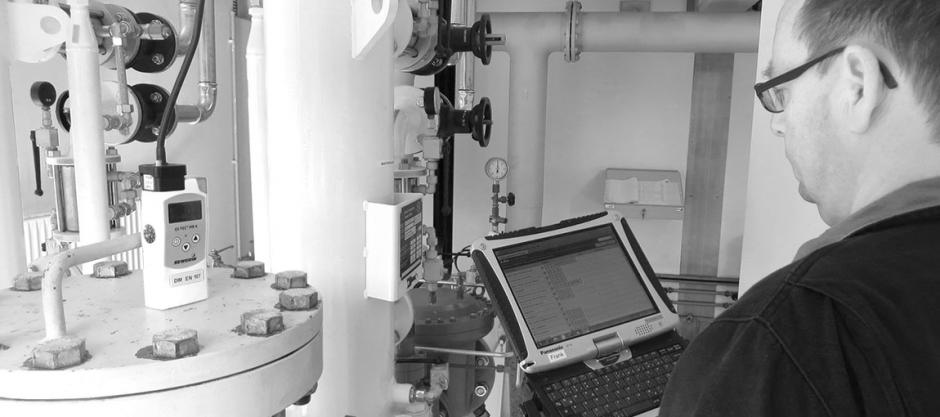As a gas network operator for areas of Brandenburg and the eastern part of Mecklenburg-Western Pomerania, E.DIS AG is responsible for the maintenance of more than 4,500 km of gas piping, including the technical periphery. Accordingly, it is important to plan and carry out the work assignments in the maintenance area with a high degree of automation. To this end, all relevant technical information, including maintenance cycles, are stored in the SAP technical database. The work orders can be triggered automatically or manually from the SAP system. The orders are updated with the necessary geo-coordinates, time frames and qualification requirements and forwarded to the workforce management solution.
The workforce management system ClickSchedule creates a central dispatch plan and forwards work orders, depending on qualifications, working hours and the technician's starting location. The orders are transferred via an encrypted connection to the mobile application. Simultaneously, the necessary technical information and geo-data is sent to the Panasonic Toughbooks.
Maintenance and inspection logs
Although planning processes were already very efficient, there was still room to improve the working documentation. As with many other network operators, at E.DIS AG technicians first filled out servicing and maintenance records on paper and then confirmed them by signature. Any equipment issues had to be recorded both on paper and in the mobile application. These double entries cost unnecessary time. Due to poor legibility, handwritten logs repeatedly resulted in problems or queries when checked by those responsible for facilities. In addition, archiving paper logs required a lot of space and was very labor-intensive. Searching for required logs took a lot of time, was not location-independent nor easily possible in the SAP system. The workflow generally at EDIS AG was problematic, because logs of recorded faults had no documentation either in the final protocol checks by facility managers.
In the Summer of 2015, E.DIS AG decided to introduce digital checklists for the documentation of all maintenance orders in the gas network in SAP-PM. This made parallel paper documentation superfluous. Alongside SAP AG, Wessendorf Software & Consulting GmbH (WSC) from Berlin was an external project partner in the 14-member project team. WSC has many years of experience in designing technical service business processes and extensive IT expertise in the implementation of mobile SAP solutions. The company supported E.DIS AG in the customized design of its service processes as well as the complete implementation of the project up to roll-out.
Generic Inspection Plans - Specific Checklists
For each work plan that requires checklists, a separate checklist template (inspection plan) is stored in the system, which defines the maximum checklist scope for each specific operation. This means an inspection plan can include several operations and can be used for both technical locations and equipment. When creating checklists for an order, a maximum of one checklist is created for each technical object. The operations of each order thereby govern which inspection plan operations are relevant. The specific classification data features of the order’s technical objects control which inspections, within the inspection plan operation, should be executed for each respective object. For example, if a house has a home connection and a gas-pressure regulator, two checklists will be generated in the respective maintenance order because there are two technical objects. In this case, the checklist is designed according to the built-in regulator type so that only the points relevant to the specific regulator type are included.
The creation of checklists for an order does not follow order placement, instead, it takes place during order scheduling and assignment, ensuring that only the most up-to-date information and checklist templates are used.
Checklists on mobile devices
After checklists for an order have been created, they are forwarded to the mobile devices of the service technicians during order synchronization. If a checklist contains several operations, they can also be assigned to different technicians. The date, time and user are saved for each on-site checklist entry made in the mobile application. This makes it possible to retrace who carried out which test at which time, should faults be found later.
The E.DIS AG mobile solution has been designed so that the technicians must first complete and store the checklist in the mobile application, before the associated order operation can be completed.
Once the results have been synchronized, the condition of each facility is evaluated for each completed checklist in the SAP system. Simultaneously, results from the checklist can automatically be transferred to the relevant measurement points, if necessary.
If no faults are detected within the checklist, the evaluation is carried out automatically. When a fault is detected, the evaluation is carried out manually by the facility manager via a new list, which enables checklist selection according to status, location, organizational data, class, etc.
After all checklists within an order have been evaluated, a protected PDF document is automatically created which includes all checklists within the order. The PDF document is stored in the SAP system and linked to the relevant technical objects and order. Only then can the order be completed.
Conclusion
In order to create the optimal solution for E.DIS AG, the SAP solution was customized to meet company-specific requirements. The implementation of list processing for checklists and test results considerably eased the documentation and handling of maintenance work. High quality technical data in the SAP system was essential to the project's success.
Another important component was the consistent and continuous involvement of employees. It is precisely when re-working and developing process sequences, that the practical experience of employees must be taken into consideration, so that the solution will be well accepted amongst its users. The early involvement of employees made it possible to sidestep many previously manual work steps, noticeably relieving the workload of E.DIS technicians and facility managers. Roughly 95% of processed checklists can now be automatically completed by the system, without having to be re-worked by facility managers. This number will rise even higher with continuous quality assurance of technical data. Thanks to the digital storage of technical objects in SAP, checklists can be called up at any time and thus provide a good basis for further improving the already very high quality of maintenance and repair work at E.DIS AG in the future.



